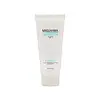What's inside
What's inside
 Key Ingredients
Key Ingredients

 Benefits
Benefits

 Concerns
Concerns

 Ingredients Side-by-side
Ingredients Side-by-side

Water
Skin ConditioningSodium Cocoyl Isethionate
CleansingGlycerin
HumectantSodium Methyl Cocoyl Taurate
CleansingCoco-Betaine
CleansingCentella Asiatica Extract
CleansingPotassium Cocoyl Glycinate
1,2-Hexanediol
Skin ConditioningPotassium Cocoate
EmulsifyingPotassium Benzoate
PreservativePolyquaternium-67
Citric Acid
BufferingSodium Chloride
MaskingButylene Glycol
HumectantDextrin
AbsorbentTheobroma Cacao Extract
Skin ConditioningDisodium EDTA
Sodium Acetate
BufferingSodium Bicarbonate
AbrasiveCoptis Chinensis Root Extract
AntioxidantSodium Hyaluronate
HumectantCoccinia Indica Fruit Extract
Skin ConditioningEclipta Prostrata Extract
Skin ConditioningWater, Sodium Cocoyl Isethionate, Glycerin, Sodium Methyl Cocoyl Taurate, Coco-Betaine, Centella Asiatica Extract, Potassium Cocoyl Glycinate, 1,2-Hexanediol, Potassium Cocoate, Potassium Benzoate, Polyquaternium-67, Citric Acid, Sodium Chloride, Butylene Glycol, Dextrin, Theobroma Cacao Extract, Disodium EDTA, Sodium Acetate, Sodium Bicarbonate, Coptis Chinensis Root Extract, Sodium Hyaluronate, Coccinia Indica Fruit Extract, Eclipta Prostrata Extract
Water
Skin ConditioningGlycerin
HumectantMyristic Acid
CleansingPalmitic Acid
EmollientStearic Acid
CleansingPotassium Hydroxide
BufferingChrysanthellum Indicum Flower Water
AntimicrobialLauric Acid
Cleansing1,2-Hexanediol
Skin ConditioningCetearyl Olivate
Butylene Glycol
HumectantSodium Lauroyl Glutamate
Sorbitan Olivate
EmulsifyingDecyl Glucoside
CleansingLimonene
PerfumingCitrus Aurantium Dulcis Peel Oil
MaskingCitrus Limon Peel Oil
MaskingEthylhexylglycerin
Skin ConditioningArachidic Acid
CleansingCitrus Aurantium Bergamia Fruit Oil
MaskingDisodium EDTA
Oleic Acid
EmollientAllantoin
Skin ConditioningDecyl Alcohol
EmollientCapric Acid
CleansingGlucose
HumectantOrbignya Oleifera Seed Oil
EmollientMalt Extract
Skin ProtectingCamellia Sinensis Leaf Extract
AntimicrobialWater, Glycerin, Myristic Acid, Palmitic Acid, Stearic Acid, Potassium Hydroxide, Chrysanthellum Indicum Flower Water, Lauric Acid, 1,2-Hexanediol, Cetearyl Olivate, Butylene Glycol, Sodium Lauroyl Glutamate, Sorbitan Olivate, Decyl Glucoside, Limonene, Citrus Aurantium Dulcis Peel Oil, Citrus Limon Peel Oil, Ethylhexylglycerin, Arachidic Acid, Citrus Aurantium Bergamia Fruit Oil, Disodium EDTA, Oleic Acid, Allantoin, Decyl Alcohol, Capric Acid, Glucose, Orbignya Oleifera Seed Oil, Malt Extract, Camellia Sinensis Leaf Extract
 Reviews
Reviews

Ingredients Explained
These ingredients are found in both products.
Ingredients higher up in an ingredient list are typically present in a larger amount.
1,2-Hexanediol is a synthetic liquid and another multi-functional powerhouse.
It is a:
- Humectant, drawing moisture into the skin
- Emollient, helping to soften skin
- Solvent, dispersing and stabilizing formulas
- Preservative booster, enhancing the antimicrobial activity of other preservatives
Butylene Glycol (or BG) is used within cosmetic products for a few different reasons:
Overall, Butylene Glycol is a safe and well-rounded ingredient that works well with other ingredients.
Though this ingredient works well with most skin types, some people with sensitive skin may experience a reaction such as allergic rashes, closed comedones, or itchiness.
Learn more about Butylene GlycolDisodium EDTA plays a role in making products more stable by aiding other preservatives.
It is a chelating agent, meaning it neutralizes metal ions that may be found in a product.
Disodium EDTA is a salt of edetic acid and is found to be safe in cosmetic ingredients.
Learn more about Disodium EDTAGlycerin is already naturally found in your skin. It helps moisturize and protect your skin.
A study from 2016 found glycerin to be more effective as a humectant than AHAs and hyaluronic acid.
As a humectant, it helps the skin stay hydrated by pulling moisture to your skin. The low molecular weight of glycerin allows it to pull moisture into the deeper layers of your skin.
Hydrated skin improves your skin barrier; Your skin barrier helps protect against irritants and bacteria.
Glycerin has also been found to have antimicrobial and antiviral properties. Due to these properties, glycerin is often used in wound and burn treatments.
In cosmetics, glycerin is usually derived from plants such as soybean or palm. However, it can also be sourced from animals, such as tallow or animal fat.
This ingredient is organic, colorless, odorless, and non-toxic.
Glycerin is the name for this ingredient in American English. British English uses Glycerol/Glycerine.
Learn more about GlycerinWater. It's the most common cosmetic ingredient of all. You'll usually see it at the top of ingredient lists, meaning that it makes up the largest part of the product.
So why is it so popular? Water most often acts as a solvent - this means that it helps dissolve other ingredients into the formulation.
You'll also recognize water as that liquid we all need to stay alive. If you see this, drink a glass of water. Stay hydrated!
Learn more about Water